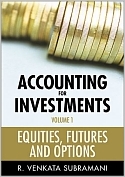| |||||
• polskie
• Zamów informacje o nowościach z wybranego tematu • kontakt |
ACCOUNTING FOR INVESTMENTS: EQUITES FUTURES AND OPTIONSSUBRAMANI R.V.wydawnictwo: WILEY, 2010, wydanie Icena netto: The 2008 financial crisis highlighted the need for responsible corporate governance within financial institutions. The key to ensuring that adequate standards are maintained lies with effective accounting and auditing standards. Accounting for Investments: Equities, Futures and Options offers a comprehensive overview of these key financial instruments and their treatment in the accounting sector, with special reference to the regulatory requirements. The book uses the US GAAP requirements as the standard model and the IFRS variants of the same are also given. Accounting for Investments starts from the basics of each financial product and:
The author also explains how the entries are reflected in the general ledger accounts, thus providing a macro level picture for the reader to understand the impact of such accounting. Lucidly written and informative, Accounting for Investments is a comprehensive guide for any professional dealing with these complex products. It also provides an accessible text for technology experts who develop software and support systems for the finance industry. Table of Contents
Foreword. Preface. Acknowledgments. Chapter 1 Financial Instruments. Learning Objectives. Accounting Standards for Financial Instruments. Definition of Financial Instruments. Categories of Financial Instruments. Fair Value Measurement Concepts. Recognition and Derecognition of Financial Instruments. Types of Investments. Difference between Investment and Speculation. Two Major Standards: U.S. GAAP and IFRS. Summary. Exercises. Chapter 2 Accounting for Equity Investments: Trading. Learning Objectives. Accounting Standards for Equity Investments. Definition of Equity Securities. Passive Investments: Less than 20 Percent. Significant Influence: 20–50 Percent. Controlling Interest—More than 50 Percent. Exchange-Traded Securities versus Over-the-counter Securities. The Trade Life Cycle for Equity Trading Securities. FX Revaluation and FX Translation Process. Trade Date Accounting versus Settlement Date Accounting. Distinction between Capital Gains and Currency Gains. Summary. Exercises. Chapter 3 Accounting for Equity Investments: Available-for-Sale. Learning Objectives. Accounting Standards for Equity Investments: Available-for-sale. Basic Understanding of AFS. The Trade Life Cycle for Available-for-sale Equity. FX Translation on AFS Securities. Impairment of AFS Securities. Summary. Exercises. Chapter 4 Transfer of Categories. Learning Objectives. Transfer between Categories. Presentation in Income Statement. Deferred Tax Effects on Unrealized Gain/Loss. Summary. Exercises. Chapter 5 Equity Derivatives: Theory. Learning Objectives. Accounting Standards for Equity Derivatives. Derivatives in a Financial Security. Definition of Derivatives per Accounting Standards. Forward Contract. Futures Contract. Futures versus Forwards. Components of a Futures Contract. Open Interest in Derivatives Contracts. Method of Computing Open Interest. What Does Change in Open Interest Indicate?. Pricing of a Futures Contract. Stock Futures and Index Futures. Summary. Exercises. Chapter 6 Accounting for Equity Index Futures. Learning Objectives. The Trade Life Cycle for Equity Index Futures. Illustrations with FX Translation. Summary. Exercises. Chapter 7 Accounting for Equity Stock Futures. Learning Objectives. Trade Life Cycle for Equity Stock Futures. Illustrations. Summary. Exercises. Chapter 8 Accounting for Equity Call Options. Learning Objectives. Accounting Standards—Derivative Instruments and Hedging Activities. Trade Life Cycle for ETOs—Long Call Non-hedging. Illustrations. Trade Life Cycle for Exchange-Traded Options—On Writing a Call Option. Illustrations. Summary. Exercises. Chapter 9 Accounting for Equity Put Options. Learning Objectives. Trade Life Cycle for Exchange-Traded Options—Long Put, Non-hedging. Illustrations. Trade Life Cycle for Exchange-Traded Options—On Writing a Put Option. Illustrations. Summary. Exercises. Chapter 10 Equity Options: Hedge Accounting. Learning Objectives. Accounting Standards—Derivative Instruments and Hedging. The Trade Life Cycle for ETOs—Long Put as Hedging. Illustrations. Summary. Exercises. Chapter 11 Accounting for Contract for Difference. Learning Objectives. Definition of CFD. Product Features of CFDs. The Trade Life Cycle for CFDs. Illustrations. Summary. Exercises. Chapter 12 Accounting for Short Equity Investments. Learning Objectives. Definition of Short Equity Securities. Types of Short Sales. Process of Short-selling. Risks of Short-selling. Box Position and Short-selling. Rationale of Short-selling. Regulatory Requirements of Short Sales. Securities Lending. The Trade Life Cycle for Equity Short Sales. Illustrations. Summary. Exercises. Chapter 13 Accounting for ADR/GDR Investments. Learning Objectives. Definition of a Depositary Receipt. Issuance and Cancellation of DRs. DR Ratio and Pricing. Benefits of DRs to Issuers. Benefits to Investors. What are ADR and GDR?. Different Types of ADR Issues. Risks Associated with Investment in DRs. Restricted Programs. The Trade Life Cycle for Equity ADR Securities. Illustrations. Summary. Exercises. Chapter 14 Presentation and Disclosures. Learning Objectives. Accounting Standards for Presentation and Disclosure. Presentation in Income Statement. Differences between U.S. GAAP and IFRS. Disclosure Requirements under U.S. GAAP. Disclosure Requirements under IFRS. Requirements by IFRS 7. Statement of Profit and Loss and Equity. Other Disclosures. Market Risk. Summary. Exercises. Appendix A Basics of Accounting Theory. Appendix B Accounting Standards for Financial Instruments. Appendix C Financial Statements of Sample Fund. Appendix D Glossary of Technical Terms. Bibliography. Index. 650 pages, Hardcover Księgarnia nie działa. Nie odpowiadamy na pytania i nie realizujemy zamówien. Do odwolania !. |


